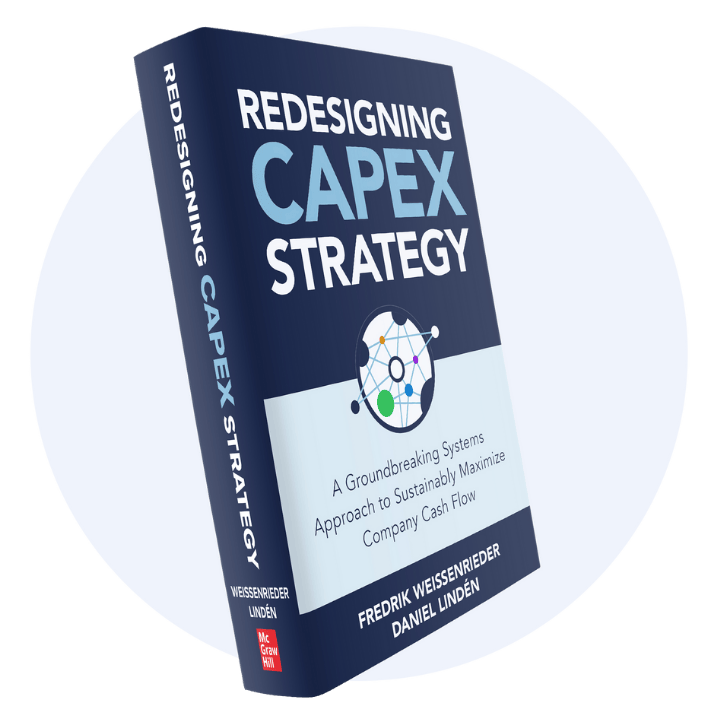Capex Strategy Architect:
Where traditional capex planning falls apart
Most capital allocation processes are still based on isolated project cases.
Decisions are made using local metrics like payback or ROI, without understanding how each investment affects the overall system. But when every decision is optimized independently, the system as a whole becomes misaligned.
Over time, high-performing assets are underfunded. Short-term wins override long-term value. Even the most well-argued business cases fail to add up when viewed across the portfolio.
Everyone senses that capital isn't going where it should. Not because the data is missing, but because the system can’t see the whole.
This is the kind of problem RECAST was built to address.
From project lists to portfolio logic
We do not rank projects in isolation. Instead, we build a full economic model of your production footprint, including every line, site, and supply loop, and simulate thousands of strategic paths.
These may include closures, capacity shifts, run-for-cash strategies, greenfield investments, or logistics adjustments. Each scenario is evaluated in the context of the full system.
We quantify the trade-offs, model constraints, and identify the sequence that delivers the highest long-term value across the portfolio.
The result is a decision-ready capital strategy. It is tested, transparent, and grounded in system-level optimization.
The questions that define capital strategy
Capital strategy is not just about choosing the right projects. It is about answering the questions that shape long-term value. If you are advising the CEO or senior leadership, you are expected to bring clarity across the system: where capital competes, where it gets stuck, and how timing changes the outcome.
🔹 Are we investing where capital creates lasting advantage, or just where it’s easiest to spend?
🔹 Should we consolidate or expand? How do we model trade-offs across time and markets?
🔹 Build or buy? What makes an acquisition truly competitive?
🔹 How do we allocate between technologies while meeting emissions goals?
🔹 Where does capital reduce fixed cost, and where is it just maintenance?
🔹 How long should we keep investing in ageing assets?
🔹 How do we time investment to protect future flexibility, not just meet this year’s plan?
We help capture your real constraints, trade-offs, and future options, so your capital strategy becomes clear, system-based, and ready to guide real decisions.
If these questions sound familiar, get in touch with us.
Or explore Capex Chat — a podcast offering expert insights and practical tools to optimize investments and elevate your capital strategy.
“Why not challenge our capex allocation processes? Are we really exploring important points with a long-term view? We at Klabin were well pleased with the results after two projects, both with involvement of our team, data mining, generating ideas and options, having thrilling discussions on scenarios and opportunities, and generating great results!”
-Francisco Razzolini, CTO, Klabin
Clarity starts here: a board-level roadmap unlocking significant value
In just 12-18 weeks, we deliver a board-level roadmap that typically lifts company cash flow by 20 to 45 per cent. Built from your real data, it captures operational constraints, models strategic options, and quantifies long-term value impact across the portfolio.
The model provides a clear view of where to invest, where to divest, what capacity is actually needed, and how capital decisions align with overall business priorities.
It shifts focus from isolated project planning to a forward-looking, system-wide capital strategy, supporting consistent, system-level decisions across operations, finance, and leadership.
Proven capex strategy. Measurable results.
Our Capex Strategy is grounded in more than two decades of applied work across capital-intensive industries.
We’ve worked with leadership teams at over 1,000 production sites, across 70+ countries, advising on portfolios worth more than $900 billion.
It connects financial logic with operational realities, so every investment aligns with long-term value, not just local ROI.
The result: clear trade-offs, smarter sequencing, and capital that flows where it creates the most impact.
Trusted by industry leaders in capital-intensive industries
- Metals & Mining
- Steel
- Copper
- Pulp & Paper
- Wood Products
- Energy Production
- Packaging
- Food
- Petrochemicals
- Downstream operations
- and more
Our strategy is built for real-world conditions inside capital-intensive industries.
We help leadership teams rethink how capital is allocated, sequenced, and optimized — not just project by project, but across the entire system.
With 30+ years of expertise, our team has helped shape Capex strategies across key industrial sectors:
The acclaimed book that’s redefining investment logic
What if the way your company makes capital decisions is fundamentally flawed, but fixable?
Redesigning Capex Strategy (McGraw-Hill, 2022) outlines a pioneering systems-based approach that’s already changing how leading corporations allocate billions in capital, more clearly, more strategically, and with far greater impact.
Written by our founders, Fredrik Weissenrieder and Daniel Lindén, the book distills over 30 years of experience reshaping capital allocation across global industry.
If you’re the one advising the CEO on investment decisions, this isn’t just a read, it’s a blueprint.
Start reading, and then ask us how to put the concepts into action!
Order the book at Barnes & Noble or Amazon or at your favorite bookseller.
The audiobook is available on Storytel, Google Play Books, or on your favorite audio platform.
“This book, and the related practical work process, provide the critical missing link between capital expenditure planning and corporate strategy.”
-Alexander Toeldte, Chairman of the Board at Clearwater Paper
Uncover the missing link in your capex strategy
Based on 25+ years of work across 500+ capital-intensive sites, “The Tail Wags the Dog” reveals why traditional project-level Capex logic, even when based on sound NPV and IRR, often leads to systemic value erosion.
Inside, you’ll discover:
✔ Why “profitable” projects often fail to improve company cash flow
✔ How capital quietly flows to the wrong assets, again and again
✔ Get practical steps to transform how capital gets allocated, company-wide, not project-by-project
When you're ready to move beyond isolated projects
If you’re exploring how to move from local project calls to a system-wide capital strategy, we’ll help you build the model and test strategic scenarios. We don’t pitch slides. We model decisions. Together.








